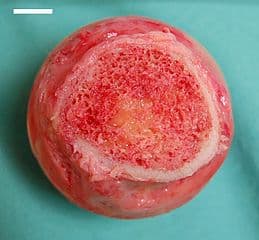Patients who receive a blood stem cell transplant from a donor outside of their family to treat leukemia and other blood diseases are more likely to have graft failure but less likely to experience graft-versus-host disease, a condition caused by the donor cells attacking the recipient’s body, if the transplanted blood cells come directly from a donor’s bone marrow, rather than from blood stem cells circulating in the donor’s bloodstream (PBSCs), according to new research. Although the study showed differences in the type and extent of complications, the results showed no difference in patient survival rates between these two major sources of donated blood cells.
The study, presented in the plenary session of the 53rd annual American Society of Hematology conference in San Diego, was conducted by the Blood and Marrow Transplant Clinical Trials Network (BMT CTN), a collaborative effort of the Center for International Blood and Marrow Transplant Research (CIBMTR) at the Medical College of Wisconsin, the National Marrow Donor Program (NMDP), and the EMMES Corporation, together with 20 core transplant centers/consortia.
The randomized study included 50 transplant centers in the United States and Canada and compared two-year survival rates for 273 patients receiving PBSC with 278 patients receiving bone marrow. The study found that survival was the same using either blood cell source, but the complications following transplant were different depending on which source was used.
PBSCs resulted in better engraftment than bone marrow, but was associated with higher rates of chronic graft-versus-host-disease (GVHD) (53% compared with 40% in bone marrow), and the GVHD was also more extensive. GVHD is a serious and often deadly post-transplant complication that occurs when the newly transplanted donor cells recognize the recipient’s own cells as foreign and attack them.
“The study shows that many patients with life-threatening blood cancers can be cured with transplants from unrelated donors but also highlights areas where new strategies are needed to improve outcomes,” said Mary Horowitz, M.D., chief scientific director of the CIBMTR at the Medical College, Robert A. Uihlein, Jr. Professor in Hematologic Research, and a co-author of the study.
This trial was supported by the National Heart, Lung, and Blood Institute (NHLBI) and the National Cancer Institute (NCI) of the National Institutes of Health (NIH) and the NMDP. Approximately 70% of patients who need an bone marrowtransplant do not have a matching donor in their family and depend on an unrelated donor. The NMDP operates the Be The Match Registry, the world’s largest listing of volunteer potential donors.
About the BMT CTN The Blood and Marrow Transplant Clinical Trials Network (BMT CTN) was established because of a critical need for multi-institutional clinical trials focused directly on improving survival for patients undergoing hematopoietic cell transplantation (HCT). Since 2001, the BMT CTN has opened more than 27 multi-institutional phase II and III trials, involved more than 100 transplant centers, and enrolled thousands of patients.
BMT CTN is funded through the National Institutes of Health (NIH) and is a collaborative effort of the CIBMTR at the Medical College of Wisconsin, the National Marrow Donor Program (NMDP), and the EMMES Corporation, together with 20 Core Transplant Centers/Consortia. Collectively, CIBMTR, NMDP and EMMES serve as the BMT CTN Data and Coordinating Center to provide administrative, statistical, scientific, and informatics support to all BMT CTN activities.
About the National Marrow Donor Program (NMDP)
The National Marrow Donor Program (NMDP) is the global leader in providing marrow and umbilical cord blood transplants to patients with leukemia, lymphoma and other diseases. The nonprofit organization matches patients with donors, educates health care professionals and conducts research so more lives can be saved. The NMDP also operates Be The Match, which provides support for patients, and enlists others in the community to join the Be The Match Registry.
If our reporting has informed or inspired you, please consider making a donation. Every contribution, no matter the size, empowers us to continue delivering accurate, engaging, and trustworthy science and medical news. Independent journalism requires time, effort, and resources—your support ensures we can keep uncovering the stories that matter most to you.
Join us in making knowledge accessible and impactful. Thank you for standing with us!

